
Every so often, we have a patient come to our clinic with a severe ingrown toenail that had started weeks ago – or sometimes even months ago. The reason for waiting so long in pain? They were waiting for it to grow out.
Truthfully, the idea that an ingrown toenail will just ‘grow out’ if it’s left for long enough is inaccurate – and has led many people to endure a lot of pain. Here’s what really happens when you leave your ingrown toenail untreated.
The Nail Will Keep Growing Deeper Into The Skin
Given that the hard nail sits on top of our toe, it’s easy to think that the painful ingrown area is along the surface of the nail too, and so will easily grow out in time, taking the pain away with it. In most of the cases we see, the reality is quite different. The ingrown portion of the nail, which we call the nail spicule, is usually located quite deep down the side of the nail – often much deeper beneath the swollen skin than you can visibly see. Waiting for your nail to grow out then means driving this nail spicule deeper into an already tender toe.
Given that toenails grow much slower than fingernails at an average rate of 1.62mm per month, and you may have multiple centimetres of skin to go through, this can mean months of severe pain, difficulty wearing shoes – and the risk of infection.
Your Toe Can Become Infected
An ingrown toenail is when the nail spicule has pierced your skin, leaving an open wound. Open wounds are susceptible to infection for the entire time before they heal, and given the proximity of the feet to the dirtier ground, you’re left with a significant risk of infection and further pain.
Treating infections isn’t always as simple as picking up a script for antibiotics, either. While antibiotics can treat simple infections, if your infection spreads to the toe bone or becomes complicated, antibiotics may not be enough, and you may develop conditions like gangrene, sepsis or osteonecrosis (bone death).
The Vicious Cycle
Another problem with leaving ingrown toenails untreated is the snowballing cycle of pain and swelling. When an ingrown nail first starts, it grows into the skin, swelling develops. The swelling puts more pressure on the nail, driving the ingrown spicule deeper into the nail. As it grows deeper, the swelling continues and may worsen, further aggravating the problem.
Ingrown Toenails Can Only Heal Once The Nail Spicule Is Removed
The only way to stop the swelling/pain cycle, remove the risk of infection, and stop the problem worsening is to remove the often small nail spicule from the skin. Once it is removed, the skin can heal, the swelling can go down, and you can get back to painless walking.
How Are Ingrown Toenails Treated?
Here at the Auckland Ingrown Toenail Clinic, our experienced podiatrists make treating ingrown toenails easy, simple and painless. Using local anaesthetic (if you want it), we remove the offending nail edge from where it is lodged in the skin, trimming that part of the nail that often lies deep beyond where you can see without the right instruments and experience.
We can either do this as a one-off, best suited for first-time ingrown toenails that are unlikely to come back, or as a permanent solution, taking extra steps to stop the problematic nail edge from growing back again – and eliminating the risk of another ingrown toenail in the future. Read about both of these services here.
Don’t Delay Treatment
The faster you have your ingrown nail treated, the better for your health and easier for your recovery. Book your appointment by calling 09 523 2333 or book your appointment online.

We often have parents of 8 to 16-year-olds bring their kids in for the second time for the same problem: an ingrown toenail on their big toe that’s causing them (both mum and child), much pain and frustration. And they usually have the same questions:
- Why has the ingrown nail come back?
- How can we stop it from coming back?
While ingrown toenails can have different causes, one of the most common causes we see in kids of this age is an incorrect nail cutting technique. And by cutting, we mean pulling/ripping/picking the nails. Here’s what you should know about this scenario and ingrown toenails for your child.
1. The way kids trim their toenails matters – a lot
When we see multiple ingrown toenail in kids, one of the first things we check is the way they’re cutting their nails. Most often – if they’re happy to admit it – they pull at their nails and rip them off. Doing this often requires kids to pull at the very end to get it all off, and so where they pull, a small spicule in the nail is left behind – instead of a smooth, straight line across the nail.
As the toenail grows, the spicule keeps moving further out until it pushes into and pierces the skin. Just like that, we have an ingrown toenail.
2. When nails are pulled, the problem is hidden
While many may try to see where the problem is and what the nail is doing, pulling the nail often hides the real problem far down the side of the nail, making it difficult for both kids and parents to fix. Even trying to trim and file the nail at this point won’t work for everyone – and often it only gives some temporary relief until the nail keeps growing out. Unfortunately, unless you deal with ingrown toenails all day every day (like us!) it’s very hard to fix what you can’t see.
3. The cost adds up
For kids with ingrown toenails, we offer two treatment types: either to remove the nail spicule as a one-off treatment, or to remove the nail spicule alongside a very small part of the nail edge, applying a solution that prevents the nail edge from growing back – and thereby solving the problem for good.
The good news is that both options will help relieve your child’s pain and symptoms. The difference is that the one-off treatment means another ingrown nail can develop on this toe – while the permanent treatment will save you from coming back to see us for more ingrown toenails (on the same toe) again and again.
As cost is often a consideration for parents so we feel it’s important to mention it here. A one-off treatment is less expensive than the permanent treatment, which is a minor surgery involving anaesthetic and dressings. However, after you’ve been back to us a few times for the same problem – the cost levels out and becomes the same (plus the one-off care costs you more time and frustration with getting to your appointments and hearing your child be in pain).
This is why most parents choose the permanent solution. The procedure is done in our clinic, in approximately one hour, while your child plays on the phone, reads or distracts themselves. We also often see parents who have tried to control the ingrown nail with the one-off care once or twice, then decide enough is enough, and opt for the minor surgery.
Want That Ingrown Nail To Stop Coming Back?
If you’ve had enough and want to get rid of that ingrown toenail once and for all – or this is your child’s first ingrown nail and you want to give them that relief (and hopefully it won’t come back for them), we’re here to help. We offer same-day ingrown toenail treatment (pending appointment availability) so book your appointment by calling 09 523 2333 or book online here.
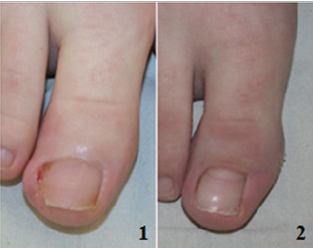
Partial nail avulsions are our most popular and effective solution to ingrown toenails – permanently. If you’re thinking about having this procedure and have heard that it involves removing a small part of the problematic edge of your toenail, you may wonder what your nail may end up looking like after it has healed.
The simple answer is that, in our clinic at least, your nail won’t look very different from its pre-surgery state. Our experienced podiatrists are careful to only remove the smallest area of nail we need to, to get the ingrown portion of the nail out confidently, while allowing us to get down to the nail-growing cells at the base of your toenail to prevent them regrowing in the future – so the problem nail edge no longer continues to give you trouble.
The result is a very straight nail edge that doesn’t curve downwards into the toe. Our patients often describe this as being unnoticeable until they point it out to someone, with which the response is “oh yeah I see what you mean”.
With this said, overall the results do vary from person to person, as everyone has natural differences in the shape of their toenail, the size and features of their toes, differences in the amount of skin surrounding their toenails, and more. More than this, some people only have minor ingrown toenails when they have the procedure, while others have severely swollen ingrown toenails, on both sides of the toenail, that have been bleeding for weeks and they’ve had to take antibiotics for the infection. All these features, particularly where there has been new excess tissue growth, can also affect the outcome and appearance of the toe once it has healed. This is something that we’re always happy to discuss with you at your first appointment when we can have a look at your toe, and help you answer any more questions you may have.
To help you get a better idea of what you can expect, here are some examples of nails after their procedure, both from our clinic and from others.
Before & three months after images of one side of the toenail being treated
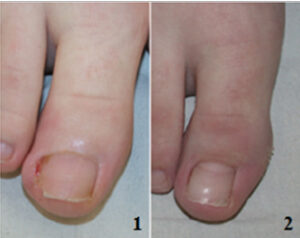 Two sides of the toenail having the procedure:
Two sides of the toenail having the procedure:
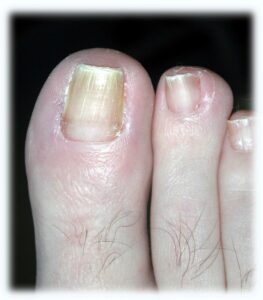 Before, two weeks after, and six months after the procedure
Before, two weeks after, and six months after the procedure
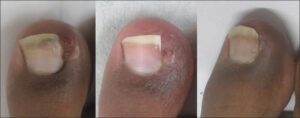 Before, two weeks after, and six months after the procedure
Before, two weeks after, and six months after the procedure
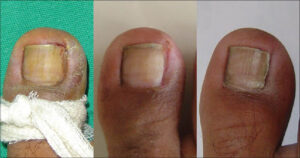 One side of the toenail, after surgery
One side of the toenail, after surgery
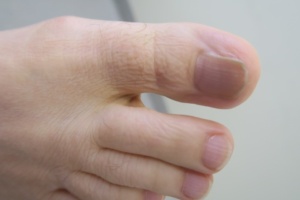 Surgery on the left side of the toenail only
Surgery on the left side of the toenail only
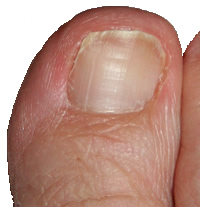
Want to know more about ingrown toenails or the nail correction procedure?
You’ve come to the right place! We’ve shared all about ingrown toenails and why they develop here. To learn more about our three treatment options for ingrown toenails, clinic on the links below:
For our commonly asked questions around ingrown toenails, please visit our FAQ page or our blog.
Ready to finally get rid of your ingrown toenail with Auckland’s experts?
Ingrown toenails are our speciality, and we’re the only clinic in Auckland to have a section of our practice completely dedicated to permanently resolving ingrown toenails. Book your appointment online here or call us on 09 523 2333
When you have diabetes, your risk of foot problems increases significantly. This is because the effects of diabetes on your nerves and blood vessels damages two critical processes when it comes to the feet and legs:
- Your sensation – the ability to feel what’s happening to and around your feet
- Your circulation – the blood flow to and around your feet
When you have an ingrown toenail, this opens you up to a number of vulnerabilities. If you don’t know much about ingrown toenails, what exactly they are or how they’re caused – read this first.
You may not be able to detect the severity of your ingrown toenail – or an infection
 As unpleasant as painful sensations are, our pain response is a very important way for our bodies to gauge what’s going on, when something is wrong, how bad it is, and alert us to take action. When we lightly strain a muscle, we get a mild pain sensation that lets us know to take it easy next time. When we break a bone, we get immense pain that lets us know to avoid putting pressure on the broken bone at all costs, so it doesn’t worsen, and can start to repair.
When our sensation is diminished, we can’t rely on our bodies to get this message to us accurately or efficiently. This leaves us vulnerable to feeling like we may have a mild achy toe, or a very minor ingrown nail that doesn’t require urgent care – whereas in reality it’s already been infected for days and needs to be treated ASAP, before the infection has a chance to reach the bone or we pick up a secondary infection.
As unpleasant as painful sensations are, our pain response is a very important way for our bodies to gauge what’s going on, when something is wrong, how bad it is, and alert us to take action. When we lightly strain a muscle, we get a mild pain sensation that lets us know to take it easy next time. When we break a bone, we get immense pain that lets us know to avoid putting pressure on the broken bone at all costs, so it doesn’t worsen, and can start to repair.
When our sensation is diminished, we can’t rely on our bodies to get this message to us accurately or efficiently. This leaves us vulnerable to feeling like we may have a mild achy toe, or a very minor ingrown nail that doesn’t require urgent care – whereas in reality it’s already been infected for days and needs to be treated ASAP, before the infection has a chance to reach the bone or we pick up a secondary infection.
If you try treating the ingrown nail yourself, it may be difficult to tell if you’ve got it out
One thing we’d expect when the nail spicule is removed from the skin it has grown into is a big feeling of relief, followed by minimal pain when pushing around the side of the nail (compared to what it used to be – you may still have some tenderness from the wound and the swelling). If your sensation is diminished, it may be hard to tell if you’ve removed all of the nail – or only part of it and it’s just going to keep giving you ongoing problems.
The beauty of having your nail spicule treated in our clinic by our podiatrists is that this is something we do every day, so can not only confidently tell when we have removed the entire nail spicule, but are also able to see it much more clearly. We also have the right tools and equipment to do a great job.
It’s worthwhile noting that we always always always recommend that those with diabetes have their ingrown toenails treated by a podiatrist only for your own safety and well-being, however, we know that this isn’t always what happens, hence it’s important to know these risks.
You may worsen the damage
Using home tools to dig around your toenail in an attempt to remove the penetrating nail spicule is a sure way to worsen the damage and make the wound bigger – leaving your body with a much bigger job when it comes to repairing the damage and closing the wound, not to mention increasing your risk of picking up an infection from the size of the wound. This is particularly important when you consider that…
You may have problems with healing the ingrown nail
Good, healthy blood flow is essential in any healing and repair process in the body. As this is impaired in diabetes sufferers, you don’t get the same volume of blood, oxygen and nutrients to the damaged site, which means closing the wound and repairing the damage can be a longer and more laborious process. It’s much the same as diabetic foot ulcers – which many people struggle and often have to have additional treatments and therapies to allow them to heal.
Your body may not be able to fight an ingrown toenail infection effectively
What else does a healthy blood supply carry with it? All the cells that fight infection and help keep us safe. When your body can’t do this effectively, the infection can worsen, spread, you can pick up a secondary infection, and generally, your health can suffer. All this without mentioning the pain and discomfort it can cause!
The best advice: Get your ingrown toenail taken care of by a podiatrist
Taking all the points above into consideration, this is why it’s incredibly important to have your ingrown toenail taken care of by a podiatrist when you have diabetes – and also when you don’t have diabetes. Don’t take our word for it – this is the official recommendation from Diabetes New Zealand, as well as Diabetes Australia and every diabetes resource we’ve ever seen worldwide.
Don’t put your feet at risk – book your appointment online here or call us on (09) 523 2333.




 Two sides of the toenail having the procedure:
Two sides of the toenail having the procedure:

 Before, two weeks after, and six months after the procedure
Before, two weeks after, and six months after the procedure
 One side of the toenail, after surgery
One side of the toenail, after surgery
 Surgery on the left side of the toenail only
Surgery on the left side of the toenail only

